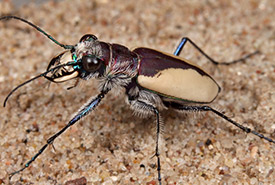
Gibson's big sand tiger beetle (Photo by Ted MacRae)
Gibson's big sand tiger beetle
One of North America’s largest tiger beetles, the Gibson’s big sand tiger beetle is among the insect world’s fiercest predators. Too small to harm humans, the Gibson’s big sand tiger beetle hunts ants and other insects with its ferocious jaws.
What does the species look like?
The Gibson’s big sand tiger beetle measures 14 to 21 millimetres in length. It is known for the beautiful dark red to purple stripe down its back, which is set against an ivory-coloured background. The stripe varies between individuals, but it is typically wider at the top and tapers to the bottom, often forming an imperfect heart shape.
The Gibson’s big sand tiger beetle has six legs, and antennae so long they could be mistaken for two extra legs. Below the antennae are two mandibles (mouth parts) used for hunting.
What is the species’ behaviour?
The Gibson’s big sand tiger beetle is so big that it can eat most insect species, including other tiger beetles within their geographical range. Due to its large body size, it warms up more slowly than most other tiger beetles and becomes active later in the morning.
Like most beetles, the Gibson’s big sand tiger beetle goes through four stages of development: egg, larval, pupal and adult. The larva burrows 30 to 200 centimetres into the ground to survive the cold Canadian winter. Come spring, the larva positions itself at the top of its cup-like burrow and hides beneath the surface. It then strikes with its mandibles at any insects that happen to fall into the mouth of its burrow.
Once fully grown, the Gibson’s big sand tiger beetle mainly hunts on foot, but it can fly to escape danger. They are better at flying than landing, however, and will often tumble to the ground upon landing.
Predators
While the Gibson’s big sand tiger beetle is a fierce predator, it is far from being at the top of the food chain. Robber flies, lizards and birds all hunt Gibson’s big sand tiger beetle.
Gibson’s big sand tiger beetles prey on ants, but the ants often fight back. It is not uncommon for researchers to find ant heads attached to parts of the beetles. This indicates that a large enough group of ants may be able to overpower the beetle, turning the hunter into the hunted.
Where does it live?
Heavily adapted to active sand dunes (dunes with little vegetation, which allows them to shift and blow in the wind), the Gibson’s big sand tiger beetle’s range is localized within southern Saskatchewan and possibly southeastern Alberta. It will eventually be pushed out if a sand dune has too much vegetation since it is not a preferred habitat type.
Gibson’s big sand tiger beetles are found on the Nature Conservancy of Canada’s (NCC’s) Dundurn property in Saskatchewan. It is also suspected that they can be found on the Asquith properties close to Saskatoon, given that the similar sandy habitat is also present at these locations.
What is its conservation status?
Recently listed as threatened under the Species at Risk Act, the Gibson’s big sand tiger beetle has been on the decline in recent years. Its biggest threat is habitat loss.
Invasive plants also play a role in the loss of this species’ habitat. Invasive plants that are better able to survive in sandy regions grow over sandy dunes. When plants stabilize a sandy area beyond a certain point, the area is no longer hospitable for several sand dune specialists, including Gibson’s big sand tiger beetle.
Active sand dune habitat in Saskatchewan is expected to continue to decline in the future. With less available habitat, Gibson’s big sand tiger beetle populations become more isolated from each other, making the species less resilient to natural population fluctuations.
What is NCC doing to protect this species?
Conserving important sand dune ecosystems is imperative.
NCC manages the growth of invasive species and will promote sustainable grazing, both of which are strategies to prevent the dunes from stabilizing on the Dundurn property, where the beetle is found.




